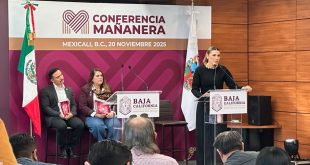 -Editorial
-Editorial
The U.S. Environmental Protection Agency released its first quarterly public update on efforts to implement a long-term solution to the Tijuana River sewage crisis, outlining progress made in coordination with the U.S. International Boundary and Water Commission. The update marks a benchmark in carrying out a memorandum of understanding signed in July 2025 by EPA Administrator Lee Zeldin and Mexico’s Secretary of Environment and Natural Resources Alicia Bárcena Ibarra.
The agency said the report fulfills a requirement of the agreement for the United States and Mexico to issue coordinated quarterly updates. According to the EPA, the two countries have advanced several projects aimed at permanently reducing transboundary sewage flows that have affected millions of residents in Southern California.
In a statement, Zeldin said the administration remains focused on achieving what it calls a “100% solution” to stop sewage from crossing the border. He emphasized transparency regarding project status and timelines, adding that the EPA’s responsibility is to protect public health and the environment.
USIBWC Commissioner Chad McIntosh said infrastructure improvements at the agency’s San Diego treatment plant are progressing, and that U.S. officials continue to monitor Mexico’s commitments under the agreement. He said information on both countries’ work will be shared with agencies and stakeholders involved in resolving the long-running contamination problem.
The update highlights several recent developments, including completion of a 10-million-gallon-per-day interim expansion at the South Bay International Wastewater Treatment Plant, Mexico’s start of construction on the first phase of the Tijuana River Gates project, and a U.S.-Mexico working group compressing timelines for key Minute 328 projects by nine months. Other actions include the completion of a nanobubble ozonation pilot project and early planning for a 50-mgd expansion of the South Bay facility.
EPA and Mexico’s Secretariat of Environment and Natural Resources are also developing strategies to address operations and maintenance costs, and negotiators from both sections of the binational boundary commission are finalizing a new diplomatic “Minute.”
The memorandum of understanding centers on three priorities: securing Mexican financial commitments, accelerating construction timelines, and adding projects needed to accommodate population growth in the Tijuana River Valley. Mexico is expected to allocate its remaining Minute 328 funds in its 2026 and 2027 budgets to support completion of projects by Dec. 31, 2027.
Planned work includes pipeline and pump station rehabilitation, wastewater treatment plant upgrades, expanded conveyance systems, and enclosing sections of open channel. December 2027 remains the deadline for completing all Minute 328 projects.
The EPA noted that since the agreement was signed, the United States has accelerated several efforts. In August, federal officials announced completion of a 10-mgd expansion of the South Bay treatment plant, a project initially estimated to take two years but finished in 100 days. The plant is expected to continue operating at full capacity through the rainy season while managing excess sediment and storm debris.
The update also summarizes Mexico’s progress in meeting its obligations under the memorandum. The next major step, according to the EPA, will be the signing of a new binational Minute by the end of 2025.



